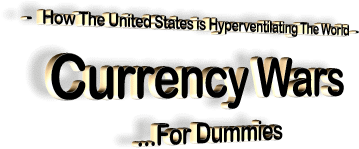
by David Chu
November 2010
from
Rense
Website
|
David Chu is a professional
engineer who has worked throughout the United States for over 19
years.
In 2008, he wrote the book, NO
FORECLOSURES!, to help Americans fight the banksters by delaying and
stopping foreclosures.
For more information on his
book, please go to www.no2foreclosures.info or you may email him at
david@no2foreclosures.info |
Three monks were walking back from a Dharma teaching with their
Master. As they arrived back at their village they noticed a flag on
a post, fluttering in the wind.
The first student looks up says, "I see
a flag flapping." The next student looks up and, trying to out-do
the first, says, "No, I see the wind flapping." The third student
even more sure of his superior understanding, glances up and says,
"I see the mind flapping."
Then their Master looks up and says, "And I see mouths flapping!"
[1]
Upon hearing such a Buddhic pronouncement, the 3
monks, who were leisurely strolling on their way to economic and financial
nirvana, stopped in their tracks and quietly closed their mouths and started
staring every which way they could to avoid the penetrating gaze of their
Master.
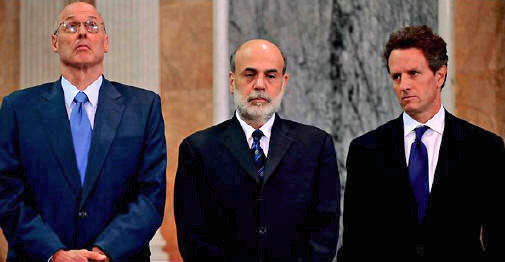
The picture of Henry "Hank"
Paulson, Jr. (left), Benjamin Shalom Bernanke, and
Timothy Franz Geithner speaks volumes, doesn't it?
No, this article is NOT about to name-call these
fine gentlemen, “The Three Stooges.” That would be paying them too fine a
compliment, not worthy of the three real Stooges: Curly Howard, Larry Fine,
and Moe Howard.
At least with Curly, Larry, and Moe, they had
you in comedic stitches, laughing and crying and backslapping.
With Hank, Ben, and Timmy, we'd be lucky if YOU
did not go postal over what they have committed, once you had figured out
what they've done that is.
Now that the much awaited suspense of what the
Federal Reserve is going to
do or not going to do to save the U.S. economy and the entire universe from
"Great Depression 2" (GD2) is finally lifted by the Fed's pronouncement on
November 3, we can all go back to our collected amnesia and wallow in our
People-magazine pop culture for the ladies and in who's going to win the
Super Bowl next February for the guys.
There's nothing to see here, move along.
But before we move along any further, I want to unequivocally state for the
record that I am not a PRINCETON/HARVARD/YALE/BULLETS/BOMBS/BANKS economist
or financial expert. [2]
Heck, I don't even consider myself as a plain
old economist or financial anything. But I do pride myself on being an
AMATEUR student in economic and financial matters of life-and-death
circumstances. [3]
In this day and age, if you are not an amateur
economist and an amateur financial expert, you are gambling with your
precious life because the odds of becoming a road kill on the Fed-brick road
are very high.
But luckily everyone who shops at Walmart and
everyone else who don't are amateur economists and financial experts, even
if they don't know it, because they are making economic decisions based on
their financial situations on a daily basis.
The Fed's QE2
Pronouncement
According to Bloomberg News,
“The Federal Reserve will buy an additional
$600 billion of Treasuries through June [2011], expanding record
stimulus and risking its credibility in a bid to reduce unemployment and
avert deflation.” [4]
This act of monetary inflation by the Fed is
euphemistically known as QE2 or “Quantitative Easing Part 2.”
With what is the Fed, helmed by the monk in the middle of the picture above,
actually going to buy the additional $600 billion of U.S. Treasuries,
Bloomberg News is purposefully vague. Short story shorter, Ben is going to
print $600 billion of digital dollars in cyberspace and email it over to the
U.S. Treasury, managed by the monk on the right, in exchange for $600
billion of Treasuries or government bonds that will be physically printed
out and handed over to the Fed.
We could only hope.
Furthermore, Bloomberg News explains,
“While Bernanke's near-zero rates and $1.7
trillion in asset purchases helped end the recession [yeah, right!], the
Fed said progress has been ʻdisappointingly slow' in bringing down
joblessness close to a 26-year high.”
If the stated purpose of the Fed's action is,
-
to reduce unemployment
-
to avert deflation
-
to end the recession,
...as the Fed and their pals in the
lame-stream
media would lead us to believe, then it has already done a hell of an
abysmal job.
Isn't the very definition of insanity this:
“Doing the same thing over and over again,
and expecting a difference result?”
After quantitative easing some $1.7 trillion
into existence from 2008 through 2009 (known as QE1), the Fed then purchased
or helped to alleviate hundreds of billions, maybe trillions, of toxic,
worth-LESS financial assets from their Wall Street gangsters and banksters,
exemplified by the monk on the left who was the CEO and Chairman of Goldman
Sachs before he exchanged his illustrious titles for that of the
U.S. Treasury Secretary under Bush II to help implement TARP ($700 billion
Troubled Asset Relief Program) and QE1. The result of TARP and QE1 is that
the U.S. economy is still sinking in the proverbial bidet.
Official unemployment, according to a recent 60 Minutes report done by Scott Pelley, is approximately 9.5% nationally.
Mr. Pelley goes on to state some very
interesting facts:
“It [the U.S. government's official
unemployment figure of 9.5%] doesn't count the people who have seen
their hours cut to part-time. It doesn't count the people who have quit
looking for work. If you add all of that together, the unemployed and
the under-employed, it's not nine and half percent. It's 17%. And here
in California, it's 22%.” [5]
What about that other ugly monster called
“deflation” that the Fed is so worried about?
If there are any doubts that
what the U.S. is currently experiencing is NOT deflation, but inflation,
here's a chart of goodies to consider: [6]
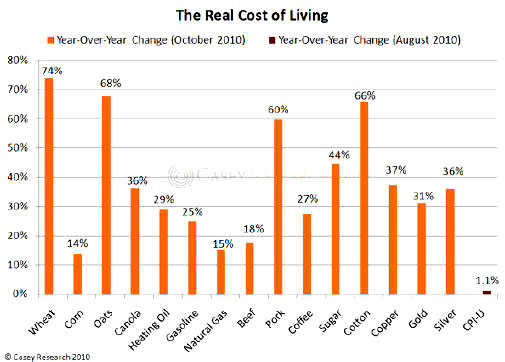
I don't know about real economists and financial
gurus, but to me real people consume things like wheat, corn, oats, canola
oil, beef, pork, coffee, and sugar.
The above chart shows that the cost of these
food items rose between 14% and 74%, comparing their wholesale prices in
October 2010 to October 2009. The average year-to-year increase of these 8
items is about 43%.
Real people also use natural resources like
heating oil, gasoline, and natural gas. Their average year-to-year increase
is 23%. So, if the wholesale prices of things real Americans consume rose
about 43% annually and the wholesale prices of resources that real Americans
use increased 23% annually, why is the official inflation index, CPI-U (the
Consumer Price Index for All Urban Consumers), indicating only a 1.1% annual
increase?
Something is very fishy here. [7]
More importantly, we note that the United States
is (or will be very shortly) experiencing inflation, not deflation, and huge
inflation at that.
The third monster that the Fed is purportedly trying to slay is the
“recession.” I don't have to tell anyone reading this article, especially
those 17% of Americans or the 22% of Californians who are unemployed and
underemployed, that the green shoots promised by Hank, Ben, and Timmy have
all withered and died, and that the U.S. will be lucky to avoid not only a
double dip recession but GD2.
So, what is the real purpose of QE2? I am so
glad you asked.
Further into the rabbit hole we go.
The Currency Hole
But before we get to the real reasons for QE2, we need to take a slight and
calculated detour and ask the following question.
Why are these 3 presidential-looking gentlemen
laughing and having such a great time?
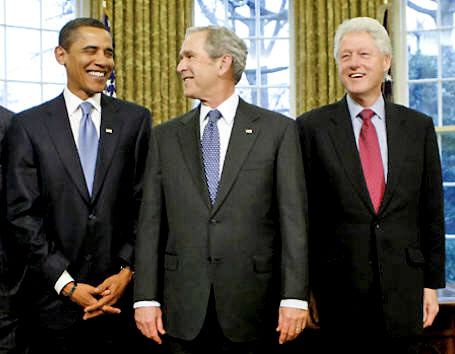
What do they know that we don't know?
In a seminal article published in February 2008
titled, “Inflation: America's Greatest Export,” Peter Schiff wrote the
following economic words of wisdom: [8]
A significant by-product of the current
global economic system, wherein Americans spend money they do not earn
to buy foreign products that they do not make, is that trillions of
dollars are now parked in foreign banks just looking for somewhere to
go.
In a healthy trade relationship, a nation pays for its imports with
equal exports that result from real productivity that pumps up demand.
In contrast, the current U.S. import boom has been created by the
artificial demand of inflation, in which increased money supply has put
more dollars in the hands of U.S. consumers...
IN SHORT, WE HAVE EXPORTED OUR INFLATION
ABROAD.
What Mr. Schiff is saying is basically what I
have said previously and the real reason why our 3 U.S. Presidents are
laughing so hard:
The joke around the world is that America
exports its monopoly money (electronically created out of thin air and
backed by nothing) in exchange for real goods and services provided by
the sweat and hard labor from the rest of the world. But the rest of the
world is finally waking up to this not-so-funny situation.
Countries like China, which still pegs its currency very closely to the
U.S. Dollar [USD] for export purposes, will be forced to allow their
currency to appreciate when the USD continues to fall.
This is because
China cannot continue to absorb the high cost of the resultant inflation
that is created there.
Mr. Schiff explains further the real problems
that this American trade “practice” is causing in export-driven countries
like China (comments in brackets and bolded emphasis in all capitalizations
are mine):
Our foreign creditors basically have two
choices as how to dispose of their excess dollars.
They can use them to
buy U.S. financial assets [priced in USD], such as bonds, stocks or real
estate, or they can exchange them for other currencies or commodities
[purposefully also priced in USD], such as gold or oil.
If they choose the former, foreign central
banks are off the hook, as those dollars find their way back to the U.S.
economy without any additional money creation [in their countries].
However, as foreigners are increasingly choosing the latter, foreign
central banks have been “forced” to print money like it's going out of
style.
In years past, foreign investors were happy to hold strong U.S. dollars,
which they either saved as a store of value, or used to purchase mighty
Wall Street stocks and bonds.
However, when the dollar began its epic swan
dive, and U.S. investments began to grossly underperform non-U.S.
alternatives, private investors dumped their dollars en masse by
exchanging them for local currencies. The unwanted dollars then became
the property and problem of foreign central banks.
If central banks did not buy these dollars, [their] citizens would have
been forced to sell their surplus dollars on the open market [if they
are able to do so]. To prevent this from happening these [central] banks
have become the buyers of first and last resort.
HOWEVER, TO SOP UP ALL OF THE EXCESS SUPPLY,
CENTRAL BANKS MUST CREATE MORE OF THEIR OWN [MONEY], RESULTING IN
RAPIDLY EXPANDING MONEY SUPPLIES [IN THEIR OWN COUNTRIES].
As much as Wall Street and government
economists pretend otherwise, the expansion of money supply is the
essential definition of inflation.
THE REAL REASON THAT PRICES ARE RISING IN
CHINA IS THAT SO MANY YUAN ARE BEING PRINTED TO BUY UP ALL THESE SURPLUS
DOLLARS.
To further illustrate what Mr. Schiff has just
said, especially his last paragraph:
China has currently $2.65 trillion worth of
foreign exchange reserves, the accumulation of U.S. dollars, European
Union's euros, British pounds, and Japanese Yen, from its massive trade
surpluses over the years.
This gargantuan amount of money is a big
headache for China's currency,
the Yuan.
Like most export-driven nations such as Russia, Brazil, and Argentina,
China's Yuan is what is called a non-convertible currency. What this means
is that the Yuan is not traded openly in international currency markets such
as in New York or London. In contrast, the U.S. dollar, the British pound,
the European Union's Euro, etc. are convertible currencies and are traded in
international foreign exchange markets.
China's Yuan is only traded within China and is
basically worthless outside of the country for individuals.
When there is an excessive amount of USD swishing around inside the Chinese
market, this condition causes the USD to depreciate or devaluate or decrease
against the Yuan. In other words, the Yuan becomes more valuable
than the USD.
This situation is abhorred greatly by China because any
significant increase in the Yuan against the USD could mean a potential loss
of Chinese export markets to other export-driven nations whose currency
remain more competitive than the Yuan.
As the Chinese Premier Wen Jiabao recently exclaimed,
“The 20-40 percent appreciation of the Yuan
demanded by U.S. lawmakers would cause many bankruptcies in the Chinese
state-owned enterprises, and cut jobs for urban workers and migrant
workers, and eventually bring in fierce social turbulence.” [9]
So what the Chinese government is doing to
prevent such Yuan appreciation is that its central bank buys up the excess
USD with Yuan.
How does China do that? Does China have hundreds
of billions of Yuan just sitting around inside the vaults of its central
bank? No, of course not! China, like everyone else, prints billions of Yuan
out of thin air! Instead of billions of USD floating in the Chinese market,
now there are even MORE billions of newly minted Yuan floating in China
(remember, it takes approximately $6.5 Yuan to buy $1 USD currently).
The net effect of this action conducted by
China's central bank is that the price of things in China gets heated up
figuratively.
If the rate of increase in goods and services produced in China for the
Chinese people does not go up as fast as the rate of increase in new Yuan
circulating in the Chinese market, then this new money will cause inflation
inside China. Price inflation is the appearance of rising prices when in
reality it is caused by too much local currency chasing the same amount of
local goods and services (i.e., real estate, stocks, foods, etc.)
Is there any evidence of such price inflation in
China?
Here is an anecdotal example of the huge inflation in China's real estate
market, specifically, in Shanghai. One of my relatives has an apartment in
Shanghai that was purchased in 2005 for $88,000 USD. Today, that apartment
is worth around $300,000 USD. This is an appreciation of almost 50% PER YEAR!
Not even during the recent housing bubble in the
San Francisco area have we witnessed such an unbelievable appreciation rate
in real estate prices.
My Argentina
Experience
For a better and more concrete example of how the United States is causing
monetary and price inflation in other countries, we visit Argentina where I
had lived for 2 years.
Argentina is also an export-driven country.
Genetically modified soybeans is one of its main exports. The Argentina peso
is also non-convertible. Argentina must also maintain the competitive edge
of its peso for the export market.
When I landed in Argentina in August 2008, the peso was trading at
approximately 3 to 1 against the USD, meaning that it took $3 pesos to buy
$1 USD. When I left in July 2010, the peso was and still is trading at
approximately 4 to 1. This translates into a depreciation or devaluation or
decrease of the Argentina peso of 24% against the USD over the past 2 years.
[10]
How did the Argentineans accomplish this feat,
especially against an ever falling USD?
Their central bank printed out
billions of pesos from thin air and then bought the excess USD inside their
country due to its accumulated trade surpluses, that's how. In fact, there
is so much monetary inflation in Argentina that they have to import
Argentina pesos from Brazil! [11]
Is there any correlation between monetary inflation and price inflation in
Argentina?
The Argentina government states that the official inflation rate in
Argentina was 8% in 2009. The International Monetary Fund (IMF) has it
pegged at 6.3%. Word on the streets is that the real inflation rate in
Argentina was 15 to 18% in 2009 (or 16.5% on average).
What about for 2010?
Official government inflation rate for 2010 is projected at 11%, while the IMF is guessing 10.6%. Barclays Capital, the giant international
investment banking firm based out of London, England, is quietly telling its
key investors to expect inflation in Argentina to be around 16.5% for 2010.
[12]
We all know that governments lie, Argentina's is
no exception.
The IMF, really an arm of the Anglo-American establishment, is
not any better.
It's really fascinating to make the following observation. The Argentina
peso depreciated from 3 to 1 in late 2008 to 4 to 1 two years later. If we
treat the USD as an iPod, it took $3 pesos to buy one iPod in August 2008
and it costs $4 pesos to buy that same iPod in 2010. So, the price of an
iPod in Argentina has gone up by 33% over 2 years. Or the inflation rate of
our iPod (or USD) is 16.7% per year. [13]
Is it just a coincidence that the inflation rate experienced by people on
the streets of Argentina (16.5% in 2009) and discussed in the private board
rooms of investment banking houses (16.5% for 2010) matches almost exactly
our theoretically derived calculation of 16.7% per year?
It would seem that the price inflation rate in
Argentina, at least, matches its monetary inflation rate for the past 2
years.
Currency Wars
It is very important for people to
understand that the United States of America and no country around the
world can devalue its way to prosperity, to [be] competitive... It is
not a viable, feasible strategy and we will not engage in it.
The U.S. Treasury Secretary, Timothy Geithner,
uttered those words on October 18, 2010. [14]
Almost everyone reading his statement assumes
what he said is that no country including the United States can devalue its
currency as the means to prosperity.
Didn't he promise that the United
States won't engage in it?
Wrong!
Please stop now and re-read what he actually said.
What Mr. Geithner actually said is the exact opposite!
He is making two
statements (1, 2 below) and trying to get away with his first statement by
covering up with his last sentence (3).
-
"It is very important for people to
understand that the United States of America can devalue its way to
prosperity, to [be] competitive..."
-
"It is very important for people to
understand that no country around the world can devalue its way to
prosperity, to [be] competitive..."
-
"It is not a viable, feasible strategy
and we will not engage in it."
How is that for double-speak?
Forget double-speak, the monetary actions of the United States through the
Fed and the Treasury speak louder than any words, as the following chart
shows the depreciation of the USD against the Euro over a 10-year period.
One USD went from buying 1.20 euros in November
2000 to just 0.70 euros in November 2010.
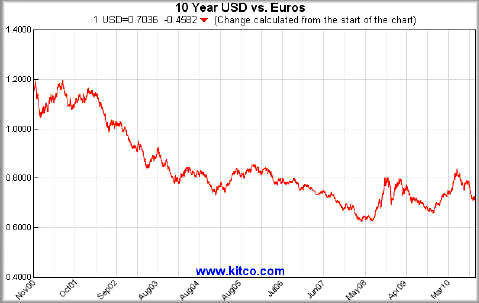
To help explain why we are having currency wars, let's look at the Chinese
Yuan.
The Yuan is valued in comparison to another currency, like the USD for
example.
For the Yuan to go up in value or to appreciate against the USD,
-
it could go up in value against a static
USD, or
-
it can remain static against a falling
USD, or
-
it could be one of many permutations
thereof.
The U.S. has been devaluating or debasing or
decreasing the worth of its USD through monetary inflation as the above
chart demonstrates, i.e., printing money from thin air and exporting most of
it to other countries, making their currencies like the Euro and Yuan more
valuable.
The Chinese, like other export-driven countries, can't allow that to happen
because it would result in losing their export market shares to these other
countries. So, they engage in devaluating or debasing or decreasing the
worth of their currency in order to keep up with the ever falling USD.
The
euphemistic term is “quantitative easing.”
The other export-driven countries, such as Japan, Brazil, India, etc., are
all engaging in the same quantitative easing scheme to keep up with China,
and, more significantly, with the crashing USD.
And so this potentially vicious circle of debasement of currencies goes on
and on.
What is the real solution to the currency wars?
UNITED STATES OF AMERICA: CEASE AND DESIST
FROM DEBASING YOUR CURRENCY!
Unfortunately, such a simple solution would
never see the light of day.
Now, let's get back on board the U.S.S. QE2.
The Real Purposes of
QE2
To put it in simplest layman's terms what is happening:
the United States is “pissing” on its
currency, the USD, by hyper-inflating it through QE1 and
QE2 and, soon
to be, QE3, i.e., it is debasing or devaluing its currency by printing
trillion of dollars out of thin air. [15]
The United States government doesn't give a damn
to what its citizens and the world think because the USD is currently the
reserve currency of the world:
-
it has the only license in the world to
freely print its currency from nothing, and the rest of the world
will gladly accept the newly minted USD
-
because it doesn't plan on paying off
its debts to countries such as China. [16]
However, the rest of the world, including China,
is catching on to this greatest
Ponzi Scheme in history.
Countries like China and Japan are slowing down
their purchase and accumulation of U.S. Treasuries due to the indisputable
fact that their holdings of U.S. government debts are losing value as the
USD continues to drop.
What is the United States going to do when other countries are not willing
to keep buying its Treasuries when it needs to finance the projected $721
billion for its Department of War (oops, I meant the Department of Defense)
in 2011, among other deficit spending expenditures?
That's where the Fed comes in and why QE2 was implemented. And,
subsequently, QE3 and QE4...
The Fed is literally forced to print trillions of USD to buy up all of the
unwanted U.S. debts in the coming months and years, as other nations stop
buying U.S. Treasuries and start selling them back to the U.S. ever so
gently and quietly.
The secondary purpose of QE2, of course, is to bail out the Wall Street banksters by providing them with liquidity at an almost zero interest rate.
The banksters, in turn, might take some of that $600 billion and use it to
shore up their bottom line or they might re-invest it in the stock market or
in other higher yield investments.
Contrary to all the pundits who are blaming the Fed for making a big mistake
for implementing QE2, the Fed is doing exactly what it was created to do.
As
an anonymous commentator on Gonzalo Lira's popular blog succinctly puts it:
[17]
Now, for the assertion that the Fed made a
mistake. Wrong!
They did exactly the best thing... FOR THE
FED!
The Fed is a
privately held [consortium] of banks. Their actions
are not necessarily intended to save us or the economy; their actions
are intended to save the banks, to drive up asset valuations so the
smart money can get out before the collapse.
Ben Bernanke was a boy wonder, child prodigy and a genius academician.
He still is. He is only doing the bidding of his betters in this, saving
the asses of the asses who drove the economy into the ground.
To hell with the best interest of the US.
Conclusions?
What conclusions can we make from all of this?
-
For one thing, massive price inflation
is coming very soon to the United States in terms of everyday retail
prices such as in food and fuel. This will probably be felt by the
average American within the next 6 to 9 months.
-
Secondly, the currency wars among the
export-driven nations will intensify as the USD keeps falling off
the financial cliff.
-
Thirdly, we are headed into Great
Depression 2 just as assuredly as the RMS Titanic headed straight to
the bottom of the Atlantic Ocean.
-
And last but not least,
another major
war, maybe even global in scale, may not be too far off in the
distance, and it will be initiated by the United States or by one of
its proxy allies in a “shock and awe” attempt to bypass and cover up
the greatest economic and financial collapse in history.
You know, maybe we should have let these final
three gentlemen handle the U.S. economy (below - from left to right: Moe Howard,
Curly Howard, and Larry Fine).
They couldn't have done a worse job than Hank,
Ben, and Timmy, or
Obama,
Bush, and
Clinton.
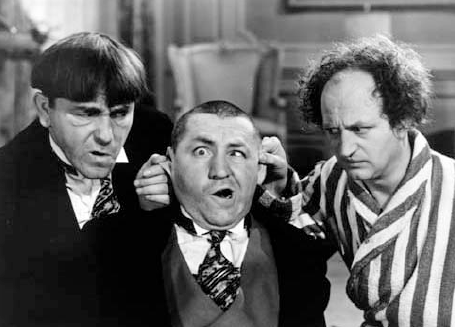
References
[1] http://buddhistsjustwannahavefun.tribe.net/thread/6e18d590-a7a8-4145-bdd4-afe3a791442f
[2] This term is coined by Gerald Celente of the Trends Research
Institute . His original wording, “Princeton, Harvard, Yale, Bullets,
Bombs, and Banks” succinctly describes the real underlying causes of the
economic and financial problems in the United States.
[3] The word “amateur” comes from the Latin words “amator” or “lover,”
and “amare” which means “to love.” To be an amateur in golf, for
example, is to love the sport.
[4] http://www.bloomberg.com/news/2010-11-03/federal-reserve-to-buy-additional-600-billion-of
securities-to-aid-growth.html
[5] http://market-ticker.org/akcs-www?post=170176
[6] http://www.shtfplan.com/headline-news/fed-clicks-print-button-saves-america-again_11032010
[7] Changes in wholesale prices usually take about 6 months to appear in
the retail markets.
[8] http://www.kitco.com/ind/Schiff/feb222008.html
[9] http://english.caijing.com.cn/2010-09-25/110529595.html
[10] The Argentina peso went from $3 pesos buying $1 USD in 2008 to $4
pesos buying $1 USD in 2010. Or another way to express this currency
ratio: from $1 peso buying $0.33 USD to $1 peso buying $0.25 USD. So,
what the peso buys in terms of the USD has gone down from $0.33 to$0.25.
This decrease can be expressed as a percentage which is equal to
(0.33-0.25)/0.33 or 0.24or 24%. The peso has depreciated by 24% over 2
years or 12% per year.
[11]
http://momento24.com/en/2010/11/03/inflation-and-growth-increase-the-printing-bills-of-100-pesos/
[12] http://en.mercopress.com/2010/01/05/argentinas-inflation-third-highest-in-the-world-say-private
consultants
[13] The price of our iPod example went from $3 to $4 pesos, or the iPod
went up in price by an amount equal to (4-3)/4 or 0.33 or 33%. Remember
this is over a 2 year period. So, our iPod increased by16.7% per year.
We can call this “monetary inflation,” as the iPod is used in place of
the USD.
[14] http://news.yahoo.com/s/nm/20101019/bs_nm/us_usa_dollar_geithner
[15] http://www.theglobeandmail.com/report-on-business/commentary/jeff-rubins-smaller-world/
quantitative-easing-is-just-devaluation/article1782626/
[16] http://dailybail.com/home/peter-schiff-of-course-were-not-going-to-pay-back-the-chines.html
[17]
http://gonzalolira.blogspot.com/2010/11/two-more-nails-in-dollars-coffinthe.html
Videos





